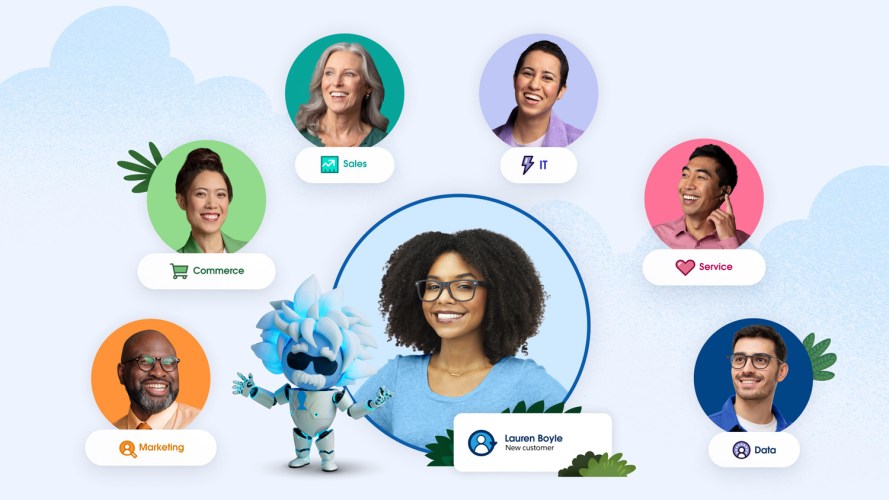You’ve been there: A customer asks you to update their information or transfer a credit, but your core business functions aren’t connected. “No, you can’t collect your online purchase from the store – that would slow distribution.” “Sorry, we can’t transfer that credit, there’s no back-end process for us to track it.” Outstanding customer experience (CX)? Hardly. Customer 360 can help.
What you’ll learn:
- What is Customer 360, exactly?
- Why Customer 360 matters for growing businesses
- Business starts with customer management tools
- Centralize the customer experience
What is Customer 360, exactly?
Customer 360 by Salesforce is a suite of deeply unified products that provides a complete view of customers across all touchpoints and interactions. They’re applications that bring together agentic AI and unified customer data from various sources, all within one deeply unified platform. With Salesforce Customer 360, teams can build stronger customer relationships through data-driven insights and seamless engagement across sales, marketing, customer service, commerce, and more.
Customer 360 is the application layer of the Salesforce Platform, with category-leading solutions for sales, service, marketing, commerce, IT, industries, partners, and more. It’s our solution to a long-standing problem: fragmented customer experiences resulting from disconnected applications and solutions that leave departments to operate in silos without a complete view of the customer.
AI Tools for Small Business
Why Customer 360 matters for growing businesses
Customers want their needs met immediately and easily, and this means having access to relevant customer data. In the latest edition of the State of Service report, only 49% of customers feel brands use their information in a beneficial way. By having the most holistic customer information at your fingertips, your teams can better meet the high expectations of today’s customer.
This is why your teams matter so much. They’re the human face of your company, your advocates, the link to the customer, and the people who can make it easy — if you give them the tools and power to do so.
Easier said than done, right? That’s where Salesforce comes in. By having an integrated suite of tools, it helps you create a 360-degree view of your customers in every app, so your team can meet your customers exactly where they are in their journey. That’s what Customer 360 is all about.
Business starts with customer management tools
According to our latest State of the AI Connected Customer report, 36% of consumers and business buyers alike expect consistent service and product quality to earn their trust. But the proportion of customers who think companies use their data to their advantage fell 11 percentage points from 2022 to 2024, from 60% to 49%.
No matter the department or team, each employee has access to one touchpoint of customer data to help them make smarter business decisions. Think of it like one big group hug, where the customer is in the center.
Wherever you are — just get started.
No matter where you are on your journey as a business owner, you can get started with Starter Suite for free — the CRM made for growth.

Centralize the customer experience
To get started with Customer 360 by Salesforce, begin by assessing your current data infrastructure to understand how customer data is currently being collected and utilized. Then, develop a clear strategy for implementing Customer 360, defining how you’ll integrate your data and use Salesforce products to deliver more personalized customer experiences.
Get started today with Customer 360. Start your journey with a free trial of Starter Suite. Looking for more customization? Explore Pro Suite. Already a Salesforce customer? Activate Foundations today to try Agentforce.
AI supported the writers and editors who created this article.
Frequently Asked Questions (FAQs)
Customer 360 is a holistic view of all the data and interactions a company has with its customers. It integrates information from various departments and touchpoints, such as sales, service, marketing, and ecommerce, into a single, unified profile.
A Customer 360 view is crucial because it helps businesses understand their customers better, personalize interactions, improve customer service, identify cross-selling and upselling opportunities, and ultimately enhance customer satisfaction and loyalty.
A comprehensive Customer 360 profile typically includes demographic information, purchase history, interaction logs (calls, emails, chat), website browsing behavior, social media activity, service requests, marketing campaign responses, and preferences.
Sales teams can use it to understand customer needs and tailor pitches. Service teams can resolve issues faster with full context. Marketing teams can segment audiences more effectively and personalize campaigns. Product development can identify pain points and desired features.
Common challenges include data silos (information scattered across different systems), data quality issues (inaccurate or incomplete data), integration complexities, and resistance to change within an organization. Overcoming these requires a strategic approach to data management and technology implementation.






























